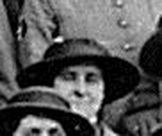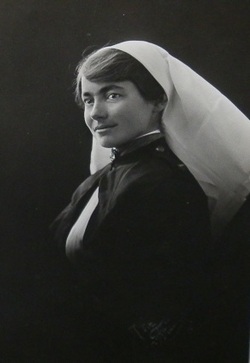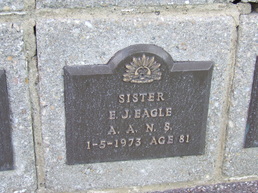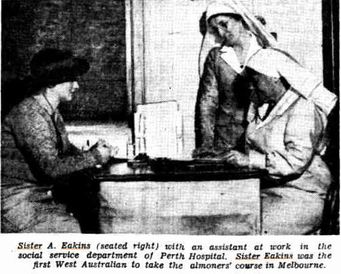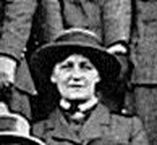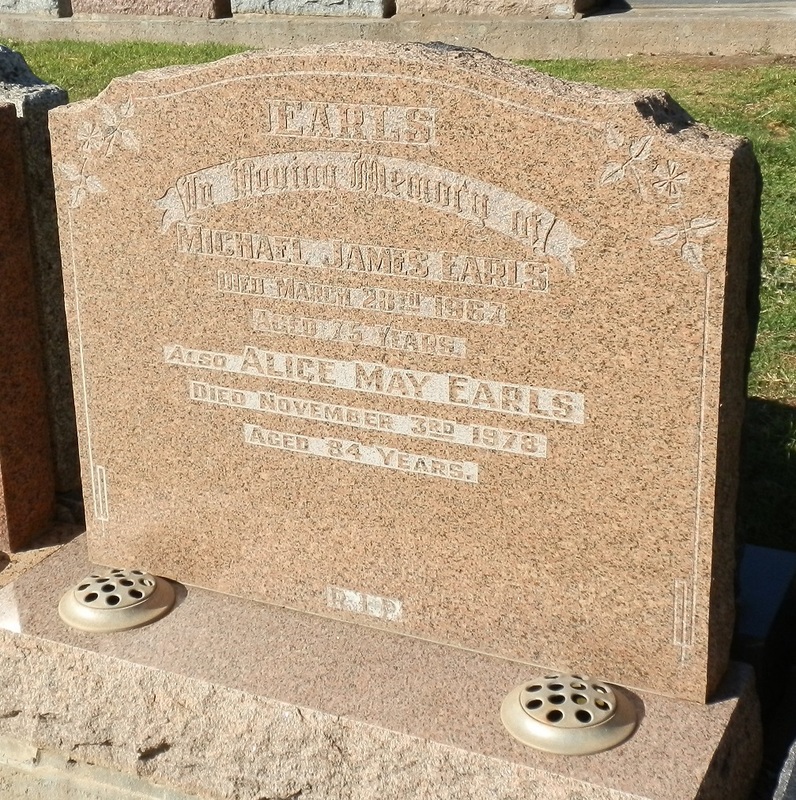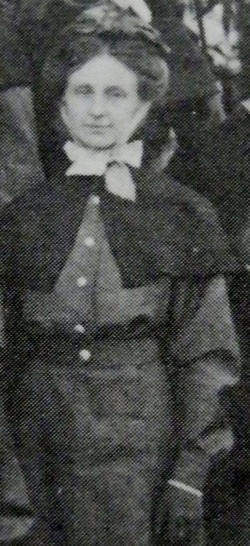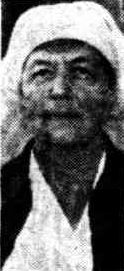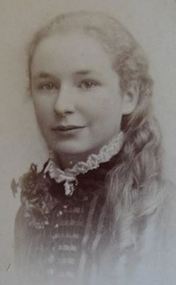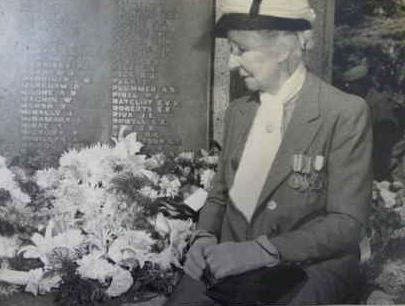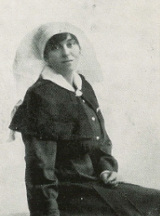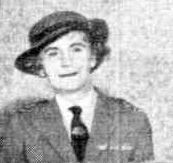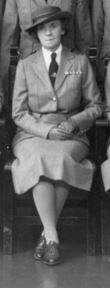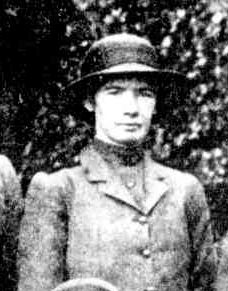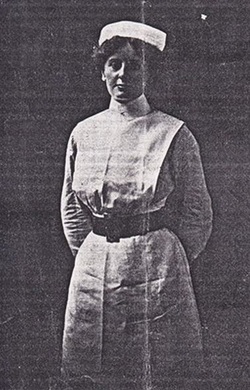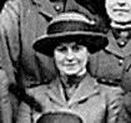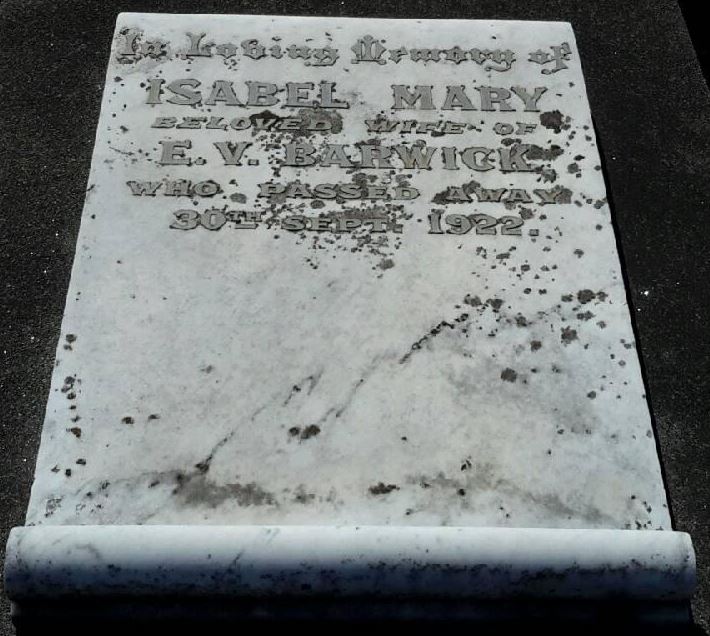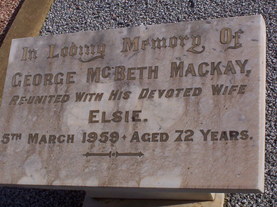EADIE, Leonora Maude
|
Staff Nurse
AANS Born 29 November 1887 at Kingston, SA Daughter of George WATSON and Mary Ann nee DAVIS Of Beaufort, SA Occupation prior to enlistment trained Nurse Trained at Children's Hospital, Adelaide Enlisted 11 May 1917 Aged 27 years Embarked 12 June 1917 from Melbourne per 'Mooltan' Embarked for Salonika 25 July 1917 per 'Chagres' ex Port Said Embarked for England 06 March 1919 Married on 29 March 1919 Charles Evan LLOYD Resigned appointment in UK 29 March 1919 due to marriage in London Died 17 October 1964 at Shropshire, England |
NURSE FAREWELLED
Miss M. Eadie. daughter of Dr. and Mrs G. A. Eadie, of Beaufort, who has been on final leave and sails for the front shortly, left Beaufort by the 5.30p.m. train on Monday. A large number of residents and friends of the family, together with representatives of the local soldiers' welcome home and farewell committee, gathered at the station, and she was given an impromptu send-off.
Cr. W. H. Halpin (president of the soldiers' farewell and welcome home committee), speaking on behalf of the citizens and members of the committee, congratulated Miss Eadie upon the step she had taken in leaving here, giving up friends and sacrificing personal comfort, to go and care for the wounded and maimed soldiers fighting for the Empire and them all. She had taken on a grave responsibility, and he commended her for her noble action. She was the first nurse to leave Beaufort and both her parents and the people, he, was sure, were very proud of her. He hoped some of the able bodied young men would step forward and follow her noble example. At the present time the country was calling for help and not getting the response she should, and when they saw a young girl going away like this, she set a striking example. Nurse Eadie had refused a public farewell, as she did not want any fuss made, and they thought the least they could do was to come here and give her a little bit of a send-ofT when she was going away. He congratulated her upon the sacrifice she was making, and her parents upon their sacrifice in letting her go. She had answered the call of king, country, and Empire by going to nurse those who required aid, and they wished her au revoir, God-speed, and a safe return to Beaufort.
Three hearty cheers-were then given for Nurse Eadie and her parents.
Captain the Rev. A. H. Ross said he had taken several large doses of quinine that day,'and was speaking under difficulties. He had had personal experience of the good done by the ladies . in this calling. He had some 18 months ago, when in hospital,after having been engaged in rough work, felt and appreciated the touch of soft, female hands. The men in the army abroad appreciated very much the work done by the nurses in the base hospitals at the front, which could not be done by anyone else. On one ship going over a number of ladies who had had nursing experience had volunteered to look after the lads in the hospital. They had lost eight men on the voyage, and would have lost twice as many but for the services of those ladies. The men had previously been looked after by hospital orderlies, Red Cross men. and Army Service Corps orderlies, who had done their best, but when the ladies got to work it was different altogether. He congratulated Miss Eadie on the step she had taken, and wished her every success and satisfaction in her work, for it was a noble work. He also hoped to be here on this station to congratulate her safe return.
In the course of response, Dr. Eadie, on behalf of his daughter and wife and himself, thanked them very sincerely for their kindness in coming here to see his daughter off. Since the outbreak of the war it had been her great ambition to go, and knowing the very perilous mission she was going on, they all naturally felt proud of her, although it was a severe wrench to part with her. He trusted God would be with her, spare her, and bring her home
to them.
Further cheers were given, and the National Anthem and'"For She's a Jolly Good Lassie " sung.
Ripinshire Advocate Saturday 02 June 1917 page 2
Miss M. Eadie. daughter of Dr. and Mrs G. A. Eadie, of Beaufort, who has been on final leave and sails for the front shortly, left Beaufort by the 5.30p.m. train on Monday. A large number of residents and friends of the family, together with representatives of the local soldiers' welcome home and farewell committee, gathered at the station, and she was given an impromptu send-off.
Cr. W. H. Halpin (president of the soldiers' farewell and welcome home committee), speaking on behalf of the citizens and members of the committee, congratulated Miss Eadie upon the step she had taken in leaving here, giving up friends and sacrificing personal comfort, to go and care for the wounded and maimed soldiers fighting for the Empire and them all. She had taken on a grave responsibility, and he commended her for her noble action. She was the first nurse to leave Beaufort and both her parents and the people, he, was sure, were very proud of her. He hoped some of the able bodied young men would step forward and follow her noble example. At the present time the country was calling for help and not getting the response she should, and when they saw a young girl going away like this, she set a striking example. Nurse Eadie had refused a public farewell, as she did not want any fuss made, and they thought the least they could do was to come here and give her a little bit of a send-ofT when she was going away. He congratulated her upon the sacrifice she was making, and her parents upon their sacrifice in letting her go. She had answered the call of king, country, and Empire by going to nurse those who required aid, and they wished her au revoir, God-speed, and a safe return to Beaufort.
Three hearty cheers-were then given for Nurse Eadie and her parents.
Captain the Rev. A. H. Ross said he had taken several large doses of quinine that day,'and was speaking under difficulties. He had had personal experience of the good done by the ladies . in this calling. He had some 18 months ago, when in hospital,after having been engaged in rough work, felt and appreciated the touch of soft, female hands. The men in the army abroad appreciated very much the work done by the nurses in the base hospitals at the front, which could not be done by anyone else. On one ship going over a number of ladies who had had nursing experience had volunteered to look after the lads in the hospital. They had lost eight men on the voyage, and would have lost twice as many but for the services of those ladies. The men had previously been looked after by hospital orderlies, Red Cross men. and Army Service Corps orderlies, who had done their best, but when the ladies got to work it was different altogether. He congratulated Miss Eadie on the step she had taken, and wished her every success and satisfaction in her work, for it was a noble work. He also hoped to be here on this station to congratulate her safe return.
In the course of response, Dr. Eadie, on behalf of his daughter and wife and himself, thanked them very sincerely for their kindness in coming here to see his daughter off. Since the outbreak of the war it had been her great ambition to go, and knowing the very perilous mission she was going on, they all naturally felt proud of her, although it was a severe wrench to part with her. He trusted God would be with her, spare her, and bring her home
to them.
Further cheers were given, and the National Anthem and'"For She's a Jolly Good Lassie " sung.
Ripinshire Advocate Saturday 02 June 1917 page 2
EAKINS, Aimee
|
Staff Nurse
AANS Born 1890 in Napier, New Zealand Daughter of John Arthur and Amelia Margaret EAKINS Sister of Isabella Jeannie DOYLE Of 14 Hanover Street, North Perth, WA Trained at Bendigo Hospital Enlisted 23 May 1917 Aged 26 years Embarked 12 June 1917 from Melbourne per 'Mooltan' Embarked from Port Said 25 July 1917 per 'Gordon' for Salonika Served in Salonika Returned to Australia per 'Bahia Castello' Appointment terminated 23 February 1920 Did not marry Died 07 February 1966 in Perth, WA Aged 75 years Resided Claremont, WA Buried Karrakatta Cemetery Anglican ZF 0186 - site expired |
PERTH HOSPITAL.
Sister Eakins' s Work.
Eulogistic reference to charitable works undertaken by various bodies in Melbourne was made by Sister A. Eakins (social service sister at Perth Hospital) in the course of an interview on Saturday morning.- Sister Eakins returned recently from a 28 days' visit to Melbourne where, through the courtesy of the Melbourne Hospital, she was able to observe the social service methods adopted there by the Almoners' Society, a report of which she furnished to the Perth Hospital Board last week. For the past six years Sister Eakins has been doing excellent work at the Perth Hospital, but her activities have necessarily been confined for the most part to in-patients. Now, with the appointment of one or two assistants, she is looking forward with enthusiasm to expanding the work on the lines of that done in Melbourne.''Of course,' she remarked, 'we will only be able to make a small beginning, but there is no knowing what it might develop into in time. There is certainly a great need for more of this sort of work. To quote one case as an example. About 12 months ago a woman came into hospital with a bad heart condition. When she was fit to be discharged we arranged to send her to a convalescent home for some time, but were not able to follow up her case, as would have been done under the Melbourne system. Now she is back in hospital as bad as ever owing to various unfortunate occurrences at home. If only it had been possible to give her a complete rest from work and worry her illness would probably not have recurred.
The Day's Round.
Outlining her daily routine at the hospital, Sister Eakins said that in the morning she got a list of new patients, examined their cards to see what their home conditions were and also to discover whether they needed any help. Then she made a round of the wards and chatted with the patients themselves and also with the sisters. Sometimes she found that a patient needed telephone messages sent to relatives, or perhaps a woman was worrying about children at home. Any matters that might be disturbing their minds were attended to in order that worries might not retard their recovery. A list of discharges was also obtained so that the sister could ascertain whether a patient desired arrangements to be made for getting home, whether there was anyone at home to look after him, and where he was to convalesce. As many patients as possible were sent to convalescent homes. Clothing very often had to be procured for out-going patients from sympathetic organisations, or sometimes from members of the hospital staff. Transferences to other institutions, such as the Old Men's Home, etc., were also arranged and, where necessary, pensions papers were filled in. There were innumerable ways in which services could be rendered. Up to the present time, the social service work had only been carried out on a very small scale compared with what was done in Melbourne, but nevertheless much good work had been accomplished. Now, with the appointment of another sister and a clerk for the clerical side of the work, the social service would be extended, but at first it would not be possible to visit homes of past patients. However, as the work extended and the staff was enlarged, it was hoped that even this would be possible.
The Origin of Almoners.
The system of almoners, as operating in Melbourne, Sister Eakins explained,had originated about 58 years ago in England, where almoners were now considered necessary for every hospital with over 100 beds. The almoner was a link-up between the hospital and the outside world. She did not work indiscriminately, but cooperated with other organisations and enlisted the interest and help of the patient himself. In Melbourne the first almoner had been sent out and financed from England until the movement was on a sound basis. There was now an Almoners' Society, which worked in close co-operation with the Charity Organisation Society. Trained social workers collected with the latter body helped considerably in investigating cases, while the Travellers' Aid Society also did invaluable work for country patients, meeting them on arrival in the city, and looking after them for three days until they were ready to enter the hospital. There were four almoners and seven third-year student almoners at the Melbourne Hospital, and also a voluntary worker who did splendid work in visiting diabetic patients in their homes for three days after their discharge from hospital. This was to ensure that they prepared their food in the correct way. A written report on every case was handed to the almoner by this worker. Sister Eakins hopes that, when the work is established on the new basis at Perth Hospital, it will be possible to enlist voluntary helpers — particularly those who could make cars available. The District Nursing Association of Victoria, she said, had a splendid system by which a car was available for the nurses every day in the year by voluntary helpers. It was also hoped to co-operate closely with the Child Welfare Department in regard to investigating the home conditions of patients.
Home Conditions Important.
Home conditions played a big part in the health of the patient, and it was therefore essential for almoners to be in full cognisance of the circumstances surrounding the lives of their patients. An understanding of psychology was also an important feature of an almoner's training. One case brought under Sister Baking's notice in Melbourne concerned a child suffering from skin disease who had been followed up for four years by the almoners. This child would be sent to hospital ,treated, discharged as cured, and would then return to hospital in a short time with the condition as bad as ever. The trouble was a nervous one, and, after investigations had been made by an almoner, it was decided that home conditions were aggravating the complaint. Therefore, with the mother's permission, the child was put in an institution. Now, after two years, the skin trouble has vanished, and soon the patient will be returned to his home, cured. Until comparatively recently, the mother had not been allowed to visit the child, as it was felt that a complete breaking away from home influence was essential to his recovery. The almoners were also doing wonderful work in regard to infantile paralysis in Melbourne. Sister Eakins continued. It was not possible to keep these cases in hospital as long as was really necessary, and they were therefore followed up into their homes and treated by itinerary masseuses who brought the patients to the doctors' clinic once a week. There were six of these itinerary masseuses. The almoners arranged for the supply of instruments and other necessities for treatment (the patients paying whatever amount they could afford), and very often children who had suffered from infantile paralysis were followed up for five or six years. Sister Eakins sees no reason why the work should not develop along similar lines in Western Australia, provided it is given sufficient support, and she is anxious to put some of her new ideas into operation. A second room has been placed at her disposal in the outpatients' department for the extension of the Work, and here her assistant sister will take up her position, and will greatly relieve the strain on the casualty room by attending to minor accidents, in addition to her other duties. Sister Eakins was for three years connected with the Child Welfare Department in Melbourne, and it was there that her deep interest in social service was stimulated. Now. with additional facilities at her disposal, it will be interesting to watch the development of this very excellent side of hospital work.
The West Australian Monday 02 July 1934 page 14
LONG SERVICE
Perth Hospital Worker Retires
The Royal Perth Hospital is to lose Miss A. Eakins, who, for health reasons, s retiring from the social service department there. Since 1928 she has been in charge of the department and has consistently fought to make West Australians aware of the need for trained social workers in the community and for medical social workers in hospital organisations. A trained nurse, Miss Eakins served in Salonica during World War I. In 1935-6 she went to Melbourne and did a special course in medical social work. Since then she has endeavoured to keep in touch with the progress that has been made in this field in other parts of Australia, England and America. As far as the Perth Hospital is concerned, she has striven to establish the department on lines comparable with those of the big hospitals in the other States of Australia and she will leave a solid foundation for future work and expansion. Nowadays the medical social worker is an essential part of a hospital team and it was through Miss Eakins's efforts that trained staff from the Eastern States and England have been employed in the department from time to time. She also established an auxiliary of voluntary car drivers, which has done a great deal to assist both the hospital and patients by transporting the latter to and from the hospital for either discharge or treatment. An ambulance for this work is now being constructed. Handicrafts taught to patients by voluntary workers of the Country Women's Association and others; correspondence lessons with the supervision of a teacher from the Education Department-these are some of the activities that Miss Eakins has started. In addition, many of her patients will remember her with gratitude and affection, while her fellow workers will remember her as one whose energies and interests are devoted to helping others.
The West Australian Tuesday 02 December 1947 page 3
Sister Eakins' s Work.
Eulogistic reference to charitable works undertaken by various bodies in Melbourne was made by Sister A. Eakins (social service sister at Perth Hospital) in the course of an interview on Saturday morning.- Sister Eakins returned recently from a 28 days' visit to Melbourne where, through the courtesy of the Melbourne Hospital, she was able to observe the social service methods adopted there by the Almoners' Society, a report of which she furnished to the Perth Hospital Board last week. For the past six years Sister Eakins has been doing excellent work at the Perth Hospital, but her activities have necessarily been confined for the most part to in-patients. Now, with the appointment of one or two assistants, she is looking forward with enthusiasm to expanding the work on the lines of that done in Melbourne.''Of course,' she remarked, 'we will only be able to make a small beginning, but there is no knowing what it might develop into in time. There is certainly a great need for more of this sort of work. To quote one case as an example. About 12 months ago a woman came into hospital with a bad heart condition. When she was fit to be discharged we arranged to send her to a convalescent home for some time, but were not able to follow up her case, as would have been done under the Melbourne system. Now she is back in hospital as bad as ever owing to various unfortunate occurrences at home. If only it had been possible to give her a complete rest from work and worry her illness would probably not have recurred.
The Day's Round.
Outlining her daily routine at the hospital, Sister Eakins said that in the morning she got a list of new patients, examined their cards to see what their home conditions were and also to discover whether they needed any help. Then she made a round of the wards and chatted with the patients themselves and also with the sisters. Sometimes she found that a patient needed telephone messages sent to relatives, or perhaps a woman was worrying about children at home. Any matters that might be disturbing their minds were attended to in order that worries might not retard their recovery. A list of discharges was also obtained so that the sister could ascertain whether a patient desired arrangements to be made for getting home, whether there was anyone at home to look after him, and where he was to convalesce. As many patients as possible were sent to convalescent homes. Clothing very often had to be procured for out-going patients from sympathetic organisations, or sometimes from members of the hospital staff. Transferences to other institutions, such as the Old Men's Home, etc., were also arranged and, where necessary, pensions papers were filled in. There were innumerable ways in which services could be rendered. Up to the present time, the social service work had only been carried out on a very small scale compared with what was done in Melbourne, but nevertheless much good work had been accomplished. Now, with the appointment of another sister and a clerk for the clerical side of the work, the social service would be extended, but at first it would not be possible to visit homes of past patients. However, as the work extended and the staff was enlarged, it was hoped that even this would be possible.
The Origin of Almoners.
The system of almoners, as operating in Melbourne, Sister Eakins explained,had originated about 58 years ago in England, where almoners were now considered necessary for every hospital with over 100 beds. The almoner was a link-up between the hospital and the outside world. She did not work indiscriminately, but cooperated with other organisations and enlisted the interest and help of the patient himself. In Melbourne the first almoner had been sent out and financed from England until the movement was on a sound basis. There was now an Almoners' Society, which worked in close co-operation with the Charity Organisation Society. Trained social workers collected with the latter body helped considerably in investigating cases, while the Travellers' Aid Society also did invaluable work for country patients, meeting them on arrival in the city, and looking after them for three days until they were ready to enter the hospital. There were four almoners and seven third-year student almoners at the Melbourne Hospital, and also a voluntary worker who did splendid work in visiting diabetic patients in their homes for three days after their discharge from hospital. This was to ensure that they prepared their food in the correct way. A written report on every case was handed to the almoner by this worker. Sister Eakins hopes that, when the work is established on the new basis at Perth Hospital, it will be possible to enlist voluntary helpers — particularly those who could make cars available. The District Nursing Association of Victoria, she said, had a splendid system by which a car was available for the nurses every day in the year by voluntary helpers. It was also hoped to co-operate closely with the Child Welfare Department in regard to investigating the home conditions of patients.
Home Conditions Important.
Home conditions played a big part in the health of the patient, and it was therefore essential for almoners to be in full cognisance of the circumstances surrounding the lives of their patients. An understanding of psychology was also an important feature of an almoner's training. One case brought under Sister Baking's notice in Melbourne concerned a child suffering from skin disease who had been followed up for four years by the almoners. This child would be sent to hospital ,treated, discharged as cured, and would then return to hospital in a short time with the condition as bad as ever. The trouble was a nervous one, and, after investigations had been made by an almoner, it was decided that home conditions were aggravating the complaint. Therefore, with the mother's permission, the child was put in an institution. Now, after two years, the skin trouble has vanished, and soon the patient will be returned to his home, cured. Until comparatively recently, the mother had not been allowed to visit the child, as it was felt that a complete breaking away from home influence was essential to his recovery. The almoners were also doing wonderful work in regard to infantile paralysis in Melbourne. Sister Eakins continued. It was not possible to keep these cases in hospital as long as was really necessary, and they were therefore followed up into their homes and treated by itinerary masseuses who brought the patients to the doctors' clinic once a week. There were six of these itinerary masseuses. The almoners arranged for the supply of instruments and other necessities for treatment (the patients paying whatever amount they could afford), and very often children who had suffered from infantile paralysis were followed up for five or six years. Sister Eakins sees no reason why the work should not develop along similar lines in Western Australia, provided it is given sufficient support, and she is anxious to put some of her new ideas into operation. A second room has been placed at her disposal in the outpatients' department for the extension of the Work, and here her assistant sister will take up her position, and will greatly relieve the strain on the casualty room by attending to minor accidents, in addition to her other duties. Sister Eakins was for three years connected with the Child Welfare Department in Melbourne, and it was there that her deep interest in social service was stimulated. Now. with additional facilities at her disposal, it will be interesting to watch the development of this very excellent side of hospital work.
The West Australian Monday 02 July 1934 page 14
LONG SERVICE
Perth Hospital Worker Retires
The Royal Perth Hospital is to lose Miss A. Eakins, who, for health reasons, s retiring from the social service department there. Since 1928 she has been in charge of the department and has consistently fought to make West Australians aware of the need for trained social workers in the community and for medical social workers in hospital organisations. A trained nurse, Miss Eakins served in Salonica during World War I. In 1935-6 she went to Melbourne and did a special course in medical social work. Since then she has endeavoured to keep in touch with the progress that has been made in this field in other parts of Australia, England and America. As far as the Perth Hospital is concerned, she has striven to establish the department on lines comparable with those of the big hospitals in the other States of Australia and she will leave a solid foundation for future work and expansion. Nowadays the medical social worker is an essential part of a hospital team and it was through Miss Eakins's efforts that trained staff from the Eastern States and England have been employed in the department from time to time. She also established an auxiliary of voluntary car drivers, which has done a great deal to assist both the hospital and patients by transporting the latter to and from the hospital for either discharge or treatment. An ambulance for this work is now being constructed. Handicrafts taught to patients by voluntary workers of the Country Women's Association and others; correspondence lessons with the supervision of a teacher from the Education Department-these are some of the activities that Miss Eakins has started. In addition, many of her patients will remember her with gratitude and affection, while her fellow workers will remember her as one whose energies and interests are devoted to helping others.
The West Australian Tuesday 02 December 1947 page 3
EARL, Ruth Rebecca Halson
Staff Nurse/Sister
AANS
Born 1887 at Bowen, Qld.
Daughter of William Henry EARL and Mary nee LOVETT
Age 27 years
Enlisted in October 1914 Cairo, Egypt
Embarked 28 November 1914
Service with 2nd AGH Egypt
Service England France and extensive service on the field
Promoted to Sister 01 December 1915
Contracted Influenza 05 July 1918
Invalided to Australia 19 October 1918 per “Sardinia”
Discharged as medically unfit (Asthma) 26 July 1919
Did not marry
Died 16 March 1953 in Sydney, NSW
AANS
Born 1887 at Bowen, Qld.
Daughter of William Henry EARL and Mary nee LOVETT
Age 27 years
Enlisted in October 1914 Cairo, Egypt
Embarked 28 November 1914
Service with 2nd AGH Egypt
Service England France and extensive service on the field
Promoted to Sister 01 December 1915
Contracted Influenza 05 July 1918
Invalided to Australia 19 October 1918 per “Sardinia”
Discharged as medically unfit (Asthma) 26 July 1919
Did not marry
Died 16 March 1953 in Sydney, NSW

Mentioned in Sir J G Maxnell’s Despatch of 01 March 1916
In connection with administration in Egypt
AIF List no 67 dated1 February 1916
In connection with administration in Egypt
AIF List no 67 dated1 February 1916
EARLS, Alice May
|
Staff Nurse
AANS Born 27 December 1893 at Callington, SA Daughter of Michael EARLS and Ellen nee CRITCHLEY Next of kin Mrs Earl, Callington, SA Training at Broken Hill Hospital Age 24 years Enlisted 30 January 1918 Duty at No 15 AGH and No 7 AGH Volunteered to nurse influenza at Adelaide Hospital Demobilized 06 July 1919 Her two brothers Joseph and Francis were killed during the war. Did not marry Died 03 November 1978 Aged 87 years Interred Centennial Park Cemetery Catholic E Path 39 Grave 764B |
EASTWOOD, Doris
Sister
AANS
Born 1893 in Geelong, Vic
Daughter of James EASTWOOD and Jane Fleming nee GATES
Address Keane St, Cottesloe, WA
Age 23 years
Training 3 years Perth Children’s Hospital
Enlisted 11 December 1916
Embarked 18 December 1916 in Fremantle per “Kaiser-I-Hind”
Service in Egypt and Salonika and England
Promoted to Sister 01 September 1917
Returned to Australia per “Medic” 10 April 1919 On Duty
Appointment terminated 23 November 1919
Married John Buller GRYLLS in 1927
Repatriation contact 26 February 1959
Died 29 October 1979 in Perth, WA
Aged 86 years
Resided Nedlands, WA
Buried Karrakatta Cemetery Anglican ZG 001
AANS
Born 1893 in Geelong, Vic
Daughter of James EASTWOOD and Jane Fleming nee GATES
Address Keane St, Cottesloe, WA
Age 23 years
Training 3 years Perth Children’s Hospital
Enlisted 11 December 1916
Embarked 18 December 1916 in Fremantle per “Kaiser-I-Hind”
Service in Egypt and Salonika and England
Promoted to Sister 01 September 1917
Returned to Australia per “Medic” 10 April 1919 On Duty
Appointment terminated 23 November 1919
Married John Buller GRYLLS in 1927
Repatriation contact 26 February 1959
Died 29 October 1979 in Perth, WA
Aged 86 years
Resided Nedlands, WA
Buried Karrakatta Cemetery Anglican ZG 001
EBER
Acting Matron
Queen Alexandra's Imperial Military Nursing Service Reserve
Returned to Australia per 'Megantic' 09 January 1920 for Tasmania
Queen Alexandra's Imperial Military Nursing Service Reserve
Returned to Australia per 'Megantic' 09 January 1920 for Tasmania
ECHLIN, Gladys Ivy (Daisy)

Awarded Royal Red Cross (2nd Class)
Date of Commonwealth of Australia Gazette: 25 July 1917
Location in Commonwealth of Australia Gazette: Page 1544, position 24
Date of London Gazette: 23 February 1917
Location in London Gazette: Page 1950, position 4
Date of Commonwealth of Australia Gazette: 25 July 1917
Location in Commonwealth of Australia Gazette: Page 1544, position 24
Date of London Gazette: 23 February 1917
Location in London Gazette: Page 1950, position 4
|
ROYAL RED CROSS.
Sister G. I. Echlin, whoso name has just appeared in the list of Australian nurses upon whom the order of the Royal Red Cross has been conferred, is the elder daughter of Captain and Mrs. R. B. Echlin. Sister Echlin received her training in the Hospital for Sick Children, Brisbane. She left Australia in a hospital ship on November 21, 1914, as staff nurse, being promoted to sister the following November. On March 12, 1916, she returned from Egypt in charge of invalid soldiers, leaving again on transport duty on April 14. Sister Echlin remained in Egypt for three months, and was then sent to England, and attached to the Royal Victoria Hospital, Netley, Southampton, and later to No.1 Australian Auxiliary Hospital, Harefield. Sister Echlin is a niece of Brigadier-General C. B. B. White, D.S.O., CB, of the Headquarters Staff, A.I.F. The Brisbane Courier Tuesday 27 February 1917 page 7 Captain and Mrs. R. B. Echlin, New Sandgate road, Albion, have received word that their daughter, Sister G. I. Echlin, R.RC, is returning to Australia by the Ascuniue, which is due in Melbourne about the 23rd instant. Sister Echlin left Brisbane on the hospital ship Kyarra in 1914, and has served in Egypt, England, and France. She was awarded the Royal Red Cross in March, 1917. The Queenslander Saturday 15 March 1919 page 40 |
EDDIE, Ida Agnes Mary
Staff Nurse
AANS
Born 30 March 1890 in Winchelsea, Victoria
Daughter of Doctor Arthur William EDDIE and Agnes nee MOIR
Address Winchelsea, Victoria
Training Dunolly Hospital, Vic
Age 27 years
Enlisted 16 June 1917
Embarked 30 June 1917 per “Somali”
Service in Bombay
Resigned Appointment 12 December 1917 due to Marriage
Did not seek payment for War Service
Married Dr David Manson of Scotland
Died October 1923 in Assam (Blackwater Fever) India
Buried India
AANS
Born 30 March 1890 in Winchelsea, Victoria
Daughter of Doctor Arthur William EDDIE and Agnes nee MOIR
Address Winchelsea, Victoria
Training Dunolly Hospital, Vic
Age 27 years
Enlisted 16 June 1917
Embarked 30 June 1917 per “Somali”
Service in Bombay
Resigned Appointment 12 December 1917 due to Marriage
Did not seek payment for War Service
Married Dr David Manson of Scotland
Died October 1923 in Assam (Blackwater Fever) India
Buried India
EDDY, Muriel Mary
|
Staff Nurse
AANS Born 11 November 1888 at Prospect, SA Daughter of James EDDY and Mary Ann nee MILLER Enlisted in Cairo, Egypt Enlisted 20 August 1915 Embarked 20 August 1915 Appointment terminated 09 June 1919 Did not marry Died 09 May 1958 at Daw Park, SA Aged 69 years Resided Brighton, SA Matron Eddy is an Adelaide woman. She served in the war as a nurse, and was a member of the nursing staff at Keswick from 1921 until about 12 months ago, when she went to Perth. She was a senior sister at the time. The Mail Adelaide Saturday 14 November 1936 page 2 |
Some "Good Germans"
Matron M. M. Eddy, of Keswick Military Hospital, who served in France and Egypt for more than three years of the last war : 'After reading about the atrocities in the papers in the past few days it is difficult to be calm about it all, but I think we have to be calm. "The individuals responsible must be punished. Don't just shoot them; shooting is too quick and painless. "For the civilian population the main problem will be education, and I believe it will be possible to find among the Germans themselves the right people to undertake this tack. "It's difficult to think of 'good Germans' just at present, but we mustn't forget the musicians and scientists of the past who prove that some of them really are 'good Germans'."
News Wednesday 25 April 1945 page 5
Matron M. M. Eddy, of Keswick Military Hospital, who served in France and Egypt for more than three years of the last war : 'After reading about the atrocities in the papers in the past few days it is difficult to be calm about it all, but I think we have to be calm. "The individuals responsible must be punished. Don't just shoot them; shooting is too quick and painless. "For the civilian population the main problem will be education, and I believe it will be possible to find among the Germans themselves the right people to undertake this tack. "It's difficult to think of 'good Germans' just at present, but we mustn't forget the musicians and scientists of the past who prove that some of them really are 'good Germans'."
News Wednesday 25 April 1945 page 5
EDGCUMBE/EDGCOMBE, Erica Valletort
Staff Nurse
AANS
Born 13 April 1889 in Healesville, Vic.
Daughter of A V and Lila EDGCUMBE
Age 29 years
Embarked 14 October 1918 in Sydney per “Wyreema”
Service in Salonika
Appointment Terminated 04 January 1919
Died 02 June 1955 at Hamilton Russell House
Resided Montrose, Vic.
Buried Melbourne General Cemetery
EDGCUMBE. - On June 2, 1955, at Hamilton Russell House, Erica Valletort (late A.A.N.S.. 1st A.I.F., and Repatriation Hospital, Caulfield), daughter of the late Lila and A. V. Edgcumbe, and sister of Ruth (deceased), Muriel (deceased), James (killed in action, A.I.F.), and John (A.I.F., deceased).
EDGCUMBE. - The Funeral of the late Sister ERICA VALLETORT EDGCUMBE (late A.A.N.S., First A.I.F., and Repatriation Hospital, Caulfield), will leave John (Roy V.) Allison's parlors, corner Glenhuntly and Hawthorn roads, Caulfield, THIS DAY (Friday), after a service commencing at 1.30 p.m., for the Melbourne General Cemetery. Carlton.
AANS
Born 13 April 1889 in Healesville, Vic.
Daughter of A V and Lila EDGCUMBE
Age 29 years
Embarked 14 October 1918 in Sydney per “Wyreema”
Service in Salonika
Appointment Terminated 04 January 1919
Died 02 June 1955 at Hamilton Russell House
Resided Montrose, Vic.
Buried Melbourne General Cemetery
EDGCUMBE. - On June 2, 1955, at Hamilton Russell House, Erica Valletort (late A.A.N.S.. 1st A.I.F., and Repatriation Hospital, Caulfield), daughter of the late Lila and A. V. Edgcumbe, and sister of Ruth (deceased), Muriel (deceased), James (killed in action, A.I.F.), and John (A.I.F., deceased).
EDGCUMBE. - The Funeral of the late Sister ERICA VALLETORT EDGCUMBE (late A.A.N.S., First A.I.F., and Repatriation Hospital, Caulfield), will leave John (Roy V.) Allison's parlors, corner Glenhuntly and Hawthorn roads, Caulfield, THIS DAY (Friday), after a service commencing at 1.30 p.m., for the Melbourne General Cemetery. Carlton.
EDGELL, Theodora Grace
Staff Nurse
Queen Alexandra's Imperial Military Nursing Service Reserve
Born 09 March 1870 at St. Leonards, Sydney, NSW
Daughter of Henry EDGELL and Charlotte Packer nee GORDON
Father's occupation listed as Manager of Coal Company & Agent for Liverpool London & Globe Insurance Co.
Educated at home
Trained at Melbourne Hospital, Vic. for Midwifery, Carlton Hospital Vic. from Jan 1904 to July 1904
Was nursing in Brisbane before departing for England
Embarked 25 March 1914 per 'Runic'
Queen Alexandra's Imperial Military Nursing Service Reserve
Born 09 March 1870 at St. Leonards, Sydney, NSW
Daughter of Henry EDGELL and Charlotte Packer nee GORDON
Father's occupation listed as Manager of Coal Company & Agent for Liverpool London & Globe Insurance Co.
Educated at home
Trained at Melbourne Hospital, Vic. for Midwifery, Carlton Hospital Vic. from Jan 1904 to July 1904
Was nursing in Brisbane before departing for England
Embarked 25 March 1914 per 'Runic'
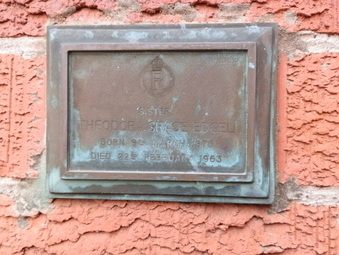
Reason for going to England:
“To see England & take up nursing for a while abroad. When war was declared I gave in my name to the Red Cross Society of Harrow, Middlesex, England, where I was staying with cousins (The Misses Edgell, 15 Lyon Rd, Harrow). But independently obtained the position of ‘Sister’ at the Auxiliary Military Hospital, Waverley Abbey, Farnham, Surrey, working there from 9th Oct 1914 to 15th June 1915. Being anxious to join the AIF, I went to London & applied to Dr Norris at Commonwealth Bureau, but he told me it was impossible to enlist without returning to Australia. Sir John McCall asked me to act as a Senior Sister in No. 6 Australian Hospital, S Kensington till the arrival of two sisters from Australia. I did so, working under Miss Lempriere & then Miss Pratt from 21st July 1915 to 1st Sept 1915 when Sisters Marchant & Christianson from Australia came. I had been accepted as member of QAIMNSR by Miss Beaches, Matron in Chief at the War Office & had to report at Queen Mary’s M Hospital, Whalley, Lancashire 1st Sept 1915, thence I was sent on HMHS ‘Massilia’ to Salonika, Lemnos & Gallipoli, whence we took about 700 sick & wounded 2nd and 3rd Dec 1915, & conveyed them to Malta & Gibralta. Later I was invalided at Malta, having contracted diphtheria from the soldiers, but resumed duty, working at an Officer’s Hospital Sliema, Malta, till recalled to England in HMHS ‘Egypt’, as I had been obliged, unwillingly, to resign, in order to return to Australia on account of shortage of nurses there & serious & protracted illness in my sister’s family. Final payments were made me by the War Office, London, on 9th May 1916 & I sailed for Australia on the 13th May 1916.”
Resided c/- Mrs. Nichols, 'Kilbrack', Doneraile Co Cork, Ireland till 03 June 1915
Resided at 15 Lyon Road, Harrow, Middlesex, England when enlisted.
Intervied by QAIMNSR 10 August 1915
Informed of acceptance 14 August 1915 and sent to Whalley
Enlisted as a Staff Nurse in QAIMNSR 01 September 1915 in London
'Staff Nurse Edgell has worked in this hospital since September 1st. She is very capable, a good Surgical Nurse and most trustworthy and reliable.'
Transferred to Malta
Resided 'Villino Postelli, Sliema, Malta
Applied for early discharge 31 March 1916
'Madam,
I have the honour to request that you will forward this my application to resign from Queen Alexandria's Imperial Military Nursing Service Reserve, from the 31st March 1916. My contract is due to expire on 31st August 1916. My reason for resigning is that my only sister is in very bad health and urgently needs me, as she lives in an isolated part of Queensland where they have suffered much from the late drought.'
Discharged 15 April 1916 and told:-
'Miss Edgell is not entitled to a return passage to Australia as she resigned before the expiration of her 12 months contact, otherwise she would have been provided with 2nd class packet passage. With regard to an indulgence passage it is suggested that the lady should apply direct to the Director of Medical Services, Australian Forces, 72 Victoria Street.'
Applied to Australian War Office for passage
'Madam,
I have the honour to request that you will be so kind as to forward this my application for an Indulgence Passage on a Hospital Ship to Australia, at the end of this month or early in May. I nursed wounded soldiers in Surrey and London from September 1914 to the end of August 1915. I then joined Queen Alexandra's Imperial Military Nursing Service, Reserve and am sorry that urgent family affairs necessitated my resignation and return to Australia. I arrived in London last evening from Malta and should be grateful for an interview with you within a few days as I desire to leave for the country next Friday,
I have the honour to be
Madam
Yours obedient servant.
T G Edgell
11 April 1916'
Returned to Australia per 'Matura' 30 June 1916
Matron of Campbell Town Hospital Tasmania
Served in WWII
Did not marry
Died 22 February 1963 in Launceston, Tas.
Aged 92 years
Buried Carr Villa Cemetery Cremation Colonnade Wall 33.00 C
“To see England & take up nursing for a while abroad. When war was declared I gave in my name to the Red Cross Society of Harrow, Middlesex, England, where I was staying with cousins (The Misses Edgell, 15 Lyon Rd, Harrow). But independently obtained the position of ‘Sister’ at the Auxiliary Military Hospital, Waverley Abbey, Farnham, Surrey, working there from 9th Oct 1914 to 15th June 1915. Being anxious to join the AIF, I went to London & applied to Dr Norris at Commonwealth Bureau, but he told me it was impossible to enlist without returning to Australia. Sir John McCall asked me to act as a Senior Sister in No. 6 Australian Hospital, S Kensington till the arrival of two sisters from Australia. I did so, working under Miss Lempriere & then Miss Pratt from 21st July 1915 to 1st Sept 1915 when Sisters Marchant & Christianson from Australia came. I had been accepted as member of QAIMNSR by Miss Beaches, Matron in Chief at the War Office & had to report at Queen Mary’s M Hospital, Whalley, Lancashire 1st Sept 1915, thence I was sent on HMHS ‘Massilia’ to Salonika, Lemnos & Gallipoli, whence we took about 700 sick & wounded 2nd and 3rd Dec 1915, & conveyed them to Malta & Gibralta. Later I was invalided at Malta, having contracted diphtheria from the soldiers, but resumed duty, working at an Officer’s Hospital Sliema, Malta, till recalled to England in HMHS ‘Egypt’, as I had been obliged, unwillingly, to resign, in order to return to Australia on account of shortage of nurses there & serious & protracted illness in my sister’s family. Final payments were made me by the War Office, London, on 9th May 1916 & I sailed for Australia on the 13th May 1916.”
Resided c/- Mrs. Nichols, 'Kilbrack', Doneraile Co Cork, Ireland till 03 June 1915
Resided at 15 Lyon Road, Harrow, Middlesex, England when enlisted.
Intervied by QAIMNSR 10 August 1915
Informed of acceptance 14 August 1915 and sent to Whalley
Enlisted as a Staff Nurse in QAIMNSR 01 September 1915 in London
'Staff Nurse Edgell has worked in this hospital since September 1st. She is very capable, a good Surgical Nurse and most trustworthy and reliable.'
Transferred to Malta
Resided 'Villino Postelli, Sliema, Malta
Applied for early discharge 31 March 1916
'Madam,
I have the honour to request that you will forward this my application to resign from Queen Alexandria's Imperial Military Nursing Service Reserve, from the 31st March 1916. My contract is due to expire on 31st August 1916. My reason for resigning is that my only sister is in very bad health and urgently needs me, as she lives in an isolated part of Queensland where they have suffered much from the late drought.'
Discharged 15 April 1916 and told:-
'Miss Edgell is not entitled to a return passage to Australia as she resigned before the expiration of her 12 months contact, otherwise she would have been provided with 2nd class packet passage. With regard to an indulgence passage it is suggested that the lady should apply direct to the Director of Medical Services, Australian Forces, 72 Victoria Street.'
Applied to Australian War Office for passage
'Madam,
I have the honour to request that you will be so kind as to forward this my application for an Indulgence Passage on a Hospital Ship to Australia, at the end of this month or early in May. I nursed wounded soldiers in Surrey and London from September 1914 to the end of August 1915. I then joined Queen Alexandra's Imperial Military Nursing Service, Reserve and am sorry that urgent family affairs necessitated my resignation and return to Australia. I arrived in London last evening from Malta and should be grateful for an interview with you within a few days as I desire to leave for the country next Friday,
I have the honour to be
Madam
Yours obedient servant.
T G Edgell
11 April 1916'
Returned to Australia per 'Matura' 30 June 1916
Matron of Campbell Town Hospital Tasmania
Served in WWII
Did not marry
Died 22 February 1963 in Launceston, Tas.
Aged 92 years
Buried Carr Villa Cemetery Cremation Colonnade Wall 33.00 C
EDIS, Margaret Dorothy
|
Sister
AANS Born 1890 in Kyabram, Vic. Daughter of John Edwin EDIS and Hannah Turner nee MENZIES Enlisted 10 August 1915 in Kalgoorlie, WA Embarked 10 August 1915 Served in France 2nd British Stationary Hospital, 2nd AGH, 24th General Hospital and 2nd CCS Returned to Australia April 1919 Appointment terminated 09 December 1919 Did not marry Died 14 August 1981 in Perth, WA Aged 91 years Buried Karrakatta Cemetery - scattered to the winds Photograph Australia's Fighting Sons of the Empire |
|
Awarded MBE 01 January 1954
Matron Margaret Dorothy Edis, of Subiaco, in recognition of her outstanding public service in, the interests of persons suffering from incurable diseases. Matron Margaret Dorothy Edis, F.C.N.A., holds a triple certificate and has been matron of the Home of Peace for the past six years. During World War I she went overseas as a nursing sister and in World War II was principal matron in Western Australia and a child welfare mother craft training sister attached to the King Edward Memorial Hospital. She was president of the Trained Nurses' Association in Western Australia 1945-50 and has been president of the Australian United Nurses' Association, W.A. Branch, since 1947. Matron Edis graduated from the Goldfields District Hospital. West Australian Friday 01 January 1954 page |
|
Conforming to the Government's plan to replace principal military matrons with sisters who have seen service overseas in this war, Principal Matron in Western Australia, Matron Margaret D. Edis, has retired. Her place has been taken by Sister Eileen Kenny. Since she accepted the position at the outbreak of war, Matron Edis has equipped and despatched abroad 112 West Australian nurses and seen them return. She favours the Government's plan, realising that methods in nursing have changed and are changing all the time, and that those women who have returned from battle areas have more up-to-date methods. 'I am, glad to be relinquishing my position to Sister Kenny who went away with the W.A. girls,' Matron Edis said. 'She has had a very varied experience in this war, having been in England, Palestine, Egypt and at an Australian base. 'Matron Edis intends to enjoy a well-earned rest, the first in three years. She and six-year-old adopted son Reggie will probably have a fishing trip, after which she will return to her profession. Born in Kyabram, Victoria, she came to Western Australia when she was very young, was educated at Kalgoorlie, and in 1915 enlisted for overseas. She saw service in Egypt, then went to France with the Second A.G.H. which was attached to a British unit.
For the girls she has seen go away and return, Matron Edis has the greatest admiration. 'I am terribly proud of them,' she said. 'Without exception, everyone of my family, as I like to think of them, has done a marvellous job.' Prior to enlistment, Matron Edis undertook the caring for premature babies at the King Edward Hospital. Her room has many pictures of happy laughing babies who once weighed only one or two pounds. One of these babies is now adopted son Reggie. The Daily News Wednesday 28 April 1943 page 5 Read more here |
EDMONSON, Margaret Esther
|
Staff Nurse
AANS Born 1889 at Temora, NSW Daughter of Joseph EDMONDSON and Martha May nee McKENZIE Age 27 years Enlisted 07 October 1916 Embarked 09 May 1917 in Sydney per “Ulysses” Service in England Invalided to Australia 09 December 1918 “Leicestershire” Discharged medically unfit (Pleurisy) 30 August 1919 Did not marry Died 1953 at Ashfield, NSW |
EDSALL, Florence Emily
|
Sister
AANS Born 02 September 1883 at Kew, Adelaide SA Daughter of Henry Daviss Howers EDSALL and Elia Jane nee PINCOMBE Sister to William EDSALL Age 29 years Enlisted 11 October 1917 at No8 AGH Embarked 05 June 1918 in Sydney per “Orontes” Service in England Returned to Australia 15 September 1918 per “Arawa” On Duty Appointment terminated 08 December 1918 Died 03 September 1920 at Daylesford, Vic. Aged 36 years Buried Brighton, Cemetery, Vic. CE ZA 1722 From Melbourne comes news of the death of Sister Florence Edsall, Western Australian member of the Australian Army Nursing Service, who during the war served overseas and was later attached to No. 8 A.G.H., Perth. Sister Edsall died at Daylesford (Victoria), where she had taken up a nursing appointment. The funeral took place on Tuesday of last week in the Brighton Cemetery. Western Mail Thursday 16 September 1920 page 27 |
EDWARDS, Elvie
Nurse Elvie Edwards (daughter of Mr. W. T. Edwards, of Sydney, and late of Stanley) has enlisted to
proceed to the front in her professional capacity.
Circular Head Chronicle Wednesday 01 May 1918 page 2
proceed to the front in her professional capacity.
Circular Head Chronicle Wednesday 01 May 1918 page 2
EDWARDS, Ethel
Nurse
AANS
4th London General Hospital
Daughter of Martin EDWARDS and Anne nee HARRIS
Enlisted 18 April 1915
Embarked 04 August 1915 in Melbourne per “Orontes”
Service in England
Resigned Appointment 02 November 1916 due to Marriage
Married Stanley E. Giderson in Lambeth, England 1916
Resided 11 Octaveris Ave, Caufield, Vic
Died 11 January 1970
Resided Caulfield, Vic.
AANS
4th London General Hospital
Daughter of Martin EDWARDS and Anne nee HARRIS
Enlisted 18 April 1915
Embarked 04 August 1915 in Melbourne per “Orontes”
Service in England
Resigned Appointment 02 November 1916 due to Marriage
Married Stanley E. Giderson in Lambeth, England 1916
Resided 11 Octaveris Ave, Caufield, Vic
Died 11 January 1970
Resided Caulfield, Vic.
EDWARDS, Ernestine Mabel
Sister
AANS
Born 1883 at Snake Valley, near Ballarat, Vic.
Daughter of Ernest George EDWARDS and Marion nee MARK
Enlisted 04 April 1917
Embarked 21 April 1917 from Melbourne per 'Karoola'
Returned to Australia
Appointment terminated 15 October 1919
Died 21 May 1959
Resided Carnegie, Vic.
Read more here
AANS
Born 1883 at Snake Valley, near Ballarat, Vic.
Daughter of Ernest George EDWARDS and Marion nee MARK
Enlisted 04 April 1917
Embarked 21 April 1917 from Melbourne per 'Karoola'
Returned to Australia
Appointment terminated 15 October 1919
Died 21 May 1959
Resided Carnegie, Vic.
Read more here
EDWARDS, Hilda Mary
Staff Nurse
AANS
Born 1890 at Grafton, NSW
Daughter of John Louis and Rachael EDWARDS
Age 26 years
Enlisted 30 August 1916 at Sydney, NSW
Embarked 25 September 1916 “Kanowna”
Service in Hospital Ship “Kanowna” England/Australia/Suez
Resigned Appointment 30 September 1918
Married John HALPIN in NSW in1920
Died 31 July 1957 in North Sydney, NSW
Resided Willoughby, NSW
AANS
Born 1890 at Grafton, NSW
Daughter of John Louis and Rachael EDWARDS
Age 26 years
Enlisted 30 August 1916 at Sydney, NSW
Embarked 25 September 1916 “Kanowna”
Service in Hospital Ship “Kanowna” England/Australia/Suez
Resigned Appointment 30 September 1918
Married John HALPIN in NSW in1920
Died 31 July 1957 in North Sydney, NSW
Resided Willoughby, NSW
EDWARDS, Isabel Yatala Mary
|
Sister
AANS Born 1878 in Kyneton, Victoria Daughter of George Hay EDWARDS and Isabel nee BAYNE Of Hobart, Tas. Address National Mutual Chambers, Hobart, Tasmania Training Hobart General Hospital Age 33 years Enlisted 18 May 1917 in Launceston Embarked 12 June 1917 per “Mooltan” Service in Salonika Promoted Sister 12 July 1919 Returned to Australia per “Runic” 20 December 1919 Medical Discharge 17 July 1920 (Malaria & Frostbite Damage to Feet) Married Edward Vincent BARWICK in 1920 Died 30 September 1922 (suddenly) at No 9 Donald Street, Prahan, Vic. Resided Prahran, Vic. Buried Brighton Cemetery, Vic. Photograph ancestry.com |
|
Sister Isabel Edwards, daughter of Mr. G H Edwards, CE, one of the senior sisters at the Hobart General Hospital, left Hobart on Tuesday for Launceston to join the military base hospital, having been engaged by the military authorities as an army nurse for the front. Sister Edwards was an extremely popular nurse at the hospital, where she will be very much missed.
Tasmanian Mail 12 April 1917 page 22 Col 4 |
EDWARDS, Laura Beryl Marguerite
Probationary Nurse
AANS
Born 1891 in Waverley, NSW
Daughter of Charles Augustus EDWARDS and Marguerite Amy nee MORGAN
Address “Taunton Dene” 18 Watson St, Bondi, NSW
No Nursing Training
Age 24 years
Enlisted 13 December 1915
Embarked 22 December 1915 per “Kanowna”
Service on Hospital Ship “Kanowna” to Egypt.
Returned to Australia 01 April 1916
Appointment Terminated 01 April 1916
Married David Gardyne Stuart LINDSAY in 1921
Died 25 November 1970 at Repatriation General Hospital, Concord, NSW
Resided Bondi, NSW
AANS
Born 1891 in Waverley, NSW
Daughter of Charles Augustus EDWARDS and Marguerite Amy nee MORGAN
Address “Taunton Dene” 18 Watson St, Bondi, NSW
No Nursing Training
Age 24 years
Enlisted 13 December 1915
Embarked 22 December 1915 per “Kanowna”
Service on Hospital Ship “Kanowna” to Egypt.
Returned to Australia 01 April 1916
Appointment Terminated 01 April 1916
Married David Gardyne Stuart LINDSAY in 1921
Died 25 November 1970 at Repatriation General Hospital, Concord, NSW
Resided Bondi, NSW
Issue regarding service medals ensued…
Letter from Mrs. LINDSAY nee EDWARDS dated 10 April 1933 to Victoria Military Barracks.
“When Volunteers were called for, for V.A.D. work on the Hospital Ship “Kanowna”, I offered my
services and was accepted and was told that the AIF did not make provision for, or employ VADs,
so we were accepted on the usual soldiers terms for four years or the duration of the war and four
months after at the rate of 3/6d per day. We sailed for unknown parts (Egypt at it turned out) on
22 December 1915.
After we sailed the A.T.N.A. (Australian Trained Nurses Association) took up the case saying we were only V.A.D.’s and there were many trained nurses waiting to go overseas and it was not fair
to them that we had gone first – quite forgetting the fact that we were not doing nurses’ work but that 28 orderlies had been released for active service and we 14 girls had taken their places – would nurses have done what we did for 3/6d a day? However, we found on our return that they had prevailed and we were discharged.
Having ranked as officers no certificate of discharge was given, but we received the ordinary AIF returned soldiers Badge, my number being 10609. I have never received my medals though having volunteered and been accepted for service aboard, and having actually served in enemy waters as far as Egypt and back.
When it is remembered that women serving in English Hospitals in England received medals it must be admitted that my services entitles me to the same, especially when I volunteered for active service abroad, irrespective of where the authorities saw fit to send me and when we left Australian waters we had no idea where we were bound for as we left under sealed orders.
If my services warranted the issue to me of the invaluable Returned Soldiers Badge AIF, I think it must be admitted that I am entitled also to the War Medals issued.”
20 April 1933 – Mrs. Lindsay nee EDWARDS was issued her British War and Victory Medals
Letter from Mrs. LINDSAY nee EDWARDS dated 10 April 1933 to Victoria Military Barracks.
“When Volunteers were called for, for V.A.D. work on the Hospital Ship “Kanowna”, I offered my
services and was accepted and was told that the AIF did not make provision for, or employ VADs,
so we were accepted on the usual soldiers terms for four years or the duration of the war and four
months after at the rate of 3/6d per day. We sailed for unknown parts (Egypt at it turned out) on
22 December 1915.
After we sailed the A.T.N.A. (Australian Trained Nurses Association) took up the case saying we were only V.A.D.’s and there were many trained nurses waiting to go overseas and it was not fair
to them that we had gone first – quite forgetting the fact that we were not doing nurses’ work but that 28 orderlies had been released for active service and we 14 girls had taken their places – would nurses have done what we did for 3/6d a day? However, we found on our return that they had prevailed and we were discharged.
Having ranked as officers no certificate of discharge was given, but we received the ordinary AIF returned soldiers Badge, my number being 10609. I have never received my medals though having volunteered and been accepted for service aboard, and having actually served in enemy waters as far as Egypt and back.
When it is remembered that women serving in English Hospitals in England received medals it must be admitted that my services entitles me to the same, especially when I volunteered for active service abroad, irrespective of where the authorities saw fit to send me and when we left Australian waters we had no idea where we were bound for as we left under sealed orders.
If my services warranted the issue to me of the invaluable Returned Soldiers Badge AIF, I think it must be admitted that I am entitled also to the War Medals issued.”
20 April 1933 – Mrs. Lindsay nee EDWARDS was issued her British War and Victory Medals
EGAN, Annie
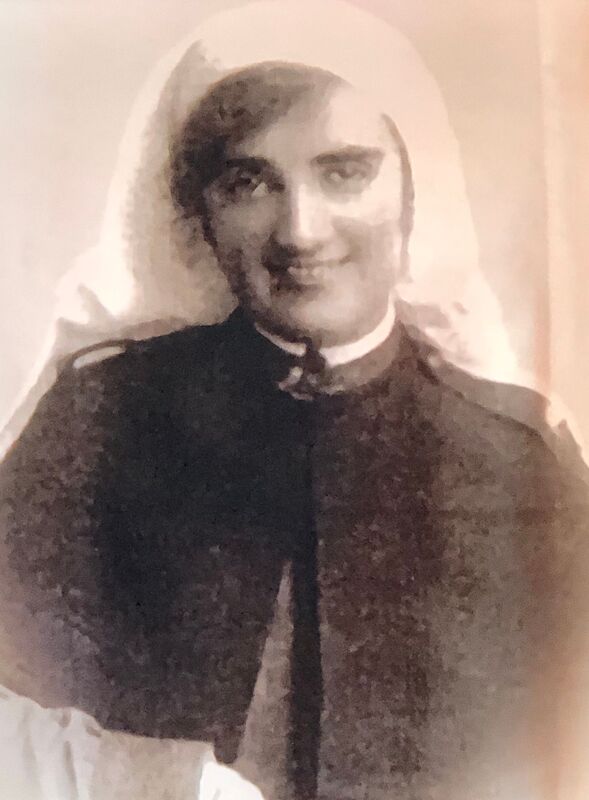
taff Nurse
AANS
Born 22 August 1891 at Gundagai, NSW
Died 03 December 1918
Buried Sydney North Head (Quarantine Cemetery) RC 3 209
Daughter of William and Ellen EGAN
Nurse Annie Egan
THE QUARANTINE HEROINE.
Nurse Annie Egan, who died in Quarantine on Tuesday, was 27 years of age. She was a daughter of William Egan, of Rosewood, Gunnedah, and commenced her training at St. Vincent's Hospital, Sydney, in May, 1915, passing the Australasian Trained Nurses' Association Examination in June, 1918. Miss Egan was a member of the Military Nursing Staff, and generously volunteered to do nursing at the Quarantine Station. She fell victim to the fatal influenza, and was admitted to Quarantine Hospital on November 26. Since then she frequently petitioned for the attendance of a priest.
She was a devout, practical Catholic. Realising she was dying, for days and nights she did not cease to implore the rites of the Church. Whilst the authorities blundered, blustered and bluffed, this girl, who, for conscience sake, was offering her young life to help to secure health to the community and to her fellow-citizens, was callously permitted to pass hence without the consolations of religion and the rites of her Church. She died on Tuesday, and was buried on Wednesday of this week. A Requiem Mass at St. Vincent's. The death of Miss Egan in the quarantine area, under such heartless and cruel circumstances, has made a very deep impression on the doctors, Sisters, and the whole nursing staff of St. Vincent's Hospital. There is the expression of very wide- spread indignation, for the deceased nurse was evidently a great favourite at St. Vincent's, and with all with whom she came in contact. By request of her nursing mates, a special Requiem Mass will be celebrated in St. Vincent's Hospital Chapel on Saturday morning, 7th inst., at 9 o'clock, in suffrage of the soul of this devout, self-sacrificing, but spiritually outraged young heroine. — R.I.P. December
AANS
Born 22 August 1891 at Gundagai, NSW
Died 03 December 1918
Buried Sydney North Head (Quarantine Cemetery) RC 3 209
Daughter of William and Ellen EGAN
Nurse Annie Egan
THE QUARANTINE HEROINE.
Nurse Annie Egan, who died in Quarantine on Tuesday, was 27 years of age. She was a daughter of William Egan, of Rosewood, Gunnedah, and commenced her training at St. Vincent's Hospital, Sydney, in May, 1915, passing the Australasian Trained Nurses' Association Examination in June, 1918. Miss Egan was a member of the Military Nursing Staff, and generously volunteered to do nursing at the Quarantine Station. She fell victim to the fatal influenza, and was admitted to Quarantine Hospital on November 26. Since then she frequently petitioned for the attendance of a priest.
She was a devout, practical Catholic. Realising she was dying, for days and nights she did not cease to implore the rites of the Church. Whilst the authorities blundered, blustered and bluffed, this girl, who, for conscience sake, was offering her young life to help to secure health to the community and to her fellow-citizens, was callously permitted to pass hence without the consolations of religion and the rites of her Church. She died on Tuesday, and was buried on Wednesday of this week. A Requiem Mass at St. Vincent's. The death of Miss Egan in the quarantine area, under such heartless and cruel circumstances, has made a very deep impression on the doctors, Sisters, and the whole nursing staff of St. Vincent's Hospital. There is the expression of very wide- spread indignation, for the deceased nurse was evidently a great favourite at St. Vincent's, and with all with whom she came in contact. By request of her nursing mates, a special Requiem Mass will be celebrated in St. Vincent's Hospital Chapel on Saturday morning, 7th inst., at 9 o'clock, in suffrage of the soul of this devout, self-sacrificing, but spiritually outraged young heroine. — R.I.P. December
EGAN, Eileen Monica
Staff Nurse
AANS
Born 1888 at Echuca, Vic.
Daughter of Patrick EGAN and Bridget Kate nee KEIRAN
Sister to Nancy EGAN
Age 28 years
Training Alfred Hospital
Enlisted 23 May 1917
Embarked 12 June 1917 in Melbourne per “Mooltan”
Service in Salonika
Dangerously ill with Pneumonia December 1918
Invalided to Australia 22 February 1919 per “Novgorrod”
Discharged as medically unfit 19 February 1920
Married Clarence Crowley in 1927
Died 11 January 1975 at Sydney, NSW
Resided Potts Point, NSW
Formerly of Echuca and Melbourne, Vic.
AANS
Born 1888 at Echuca, Vic.
Daughter of Patrick EGAN and Bridget Kate nee KEIRAN
Sister to Nancy EGAN
Age 28 years
Training Alfred Hospital
Enlisted 23 May 1917
Embarked 12 June 1917 in Melbourne per “Mooltan”
Service in Salonika
Dangerously ill with Pneumonia December 1918
Invalided to Australia 22 February 1919 per “Novgorrod”
Discharged as medically unfit 19 February 1920
Married Clarence Crowley in 1927
Died 11 January 1975 at Sydney, NSW
Resided Potts Point, NSW
Formerly of Echuca and Melbourne, Vic.
EGGLESTON, Eva Olive
|
Sister
AANS Born 05 January 1883 at Wattle Flat, NSW Daughter to George EGGLESTON and Henrietta nee SOUTHCOTT Of Rushwood, NSW Age 31 years Trained at the Salvation Army's Bethesda Hospital in Melbourne Enlisted 02 September 1915 Embarked 12 November 1915 per “Orsova” Service Egypt, France and England Promoted to Sister 01 October 1918 Contracted Influenza February 1919 Undertook a course on Domestic Economy in uk 28.4.19 to 31.7.19 Returned to Australia per 02 November “Wahehe” On Duty Appointment Terminated 25 April 1920 Repatriation Contact 12 October 1959 Did not marry Died 12 September 1967 in Marrickville, NSW Lake of Marrickville, NSW Adjutant Eggleston, of Cumnock,who served as a Salvation Army nurse with the A.I.F. for five years, has been appointed for nursing work among the poor in the districts of Pyrmont and Alexandria, Sydney. Western Champion (Parkes NSW) Thursday 23 September 1920 page 4 |
|
Eva Olive Eggleston was born on 5 January 1883 at Wattle Flat, a little village just north of Bathurst. She entered the Army Training Home on 12 January 1909 from the Corps in the little town of Hillgrove in the Armidale area of NSW . Eva was appointed to Bethesda a year later. She enlisted in the AANS on 12 October 1915 and worked at the Military Hospital at Broadmedows Melbourne for approximately 2 months along with Jane Gant, Georgina Collins and Alice Toft before she sailed to Egypt with her three collegue Officer/Nurses. It was in Egypt that Eva started her diary. Almost nothing is said in the diary about the trip to Egypt. Her diary contains a large amount of material regarding Egypt and her service there. She frequently mentions the Army and fellow Salvationists serving in the Military. One of her observations was that as Nurses they had to act as Mother, sisters and cousins to ‘the Boys. She often mentions having “spritual talks” with young soldiers; and the need to have “good Salvation Army Meetings”, so throughout WW1, her diary indicates that whatever she saw and did she remained true to her calling as a Salvation Army Officer Eva served in Egypt, was separated from her collegues and served in England and France. Eva was discharged on 25 April 1920. She returned to her Army service, transferring to the Australia Eastern Territory and retiring as Brigadier and Matron of Bethesda Maternity Hospital Marrickville in 1943,being followed in that position by Brigadier Mildred Lawrence. Courtesy of Dennis Garland and The Salvation Army |
EGLINTON/EGLINGTON, Elsie Annie
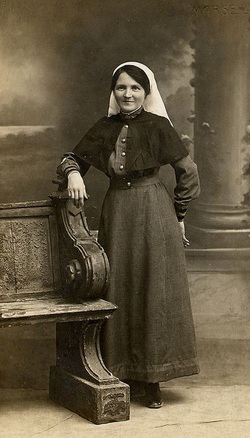
Sister
2nd Australian General Hospital
Born 28 March 1883 at O'Halloran Hill, SA
Son of James EGLINGTON and Jane Elizabeth nee RAE
Of Reynella, SA
Occupation prior to enlistment Nurse
Aged 31 years
Enlisted 05 February 1916 in Cairo, Egypt
Embarked 05 December 1914
Served in France and England
Discharged due to marriage on 10 August 1917 in London
Married George McBeth MACKAY at Whalley, Lancashire, England on 10 August 1917. She had
two children- Malcolm George Mackay born 1919 Brighton South Australia. He was a sub
Lieutenant in the navy during WW11. He was also a Presbyterian minister. He was elected
to the House of Representatives from 1963 to 1972 and was a Minister for the Navy. He
was also made a Member of the Order of Australia. He and his wife were killed in a car
crash 1999. Her daughter was Margaret Agnes McBeth Mackay born in Glenelg in 1922.
She was also a nurse and a matron in Nauru.
Family of one Son and one Daughter
Elsie died 09 July 1955 at home 47 Arthur Street. Unley, SA
Cause of death Emphysema, Bronchitis, Suspected Metastatic Carcinoma of Medicastimum
Aged 72 years
Resided 47 Arthur Street, Unley, SA
Buried North Brighton Cemetery
State Records of SA GRG 26/5/4/2123
2nd Australian General Hospital
Born 28 March 1883 at O'Halloran Hill, SA
Son of James EGLINGTON and Jane Elizabeth nee RAE
Of Reynella, SA
Occupation prior to enlistment Nurse
Aged 31 years
Enlisted 05 February 1916 in Cairo, Egypt
Embarked 05 December 1914
Served in France and England
Discharged due to marriage on 10 August 1917 in London
Married George McBeth MACKAY at Whalley, Lancashire, England on 10 August 1917. She had
two children- Malcolm George Mackay born 1919 Brighton South Australia. He was a sub
Lieutenant in the navy during WW11. He was also a Presbyterian minister. He was elected
to the House of Representatives from 1963 to 1972 and was a Minister for the Navy. He
was also made a Member of the Order of Australia. He and his wife were killed in a car
crash 1999. Her daughter was Margaret Agnes McBeth Mackay born in Glenelg in 1922.
She was also a nurse and a matron in Nauru.
Family of one Son and one Daughter
Elsie died 09 July 1955 at home 47 Arthur Street. Unley, SA
Cause of death Emphysema, Bronchitis, Suspected Metastatic Carcinoma of Medicastimum
Aged 72 years
Resided 47 Arthur Street, Unley, SA
Buried North Brighton Cemetery
State Records of SA GRG 26/5/4/2123
EKERS, Louie
Staff Nurse
AANS
Born Louisa Johann Augusta EGGERS 27 October 1882 at Concordia, SA
Daughter of Carl Frederick Wilhelm EGGERS and Anna Maria nee KONSAG
Address Wasleys, SA
Training 3 years Adelaide General Hospital
Age 34 years
Initially rejected due to German name – changed name to EKERS
Enlisted successfully 05 November 1917 at Keswick, SA
Embarked 16 November 1917 per “Canberra” in Adelaide
Service in Bombay
Returned to Australia per “Montoro” 27 December 1919
Admitted to No7 AGH, suspected TB 05 September 1920 on full pension
Married Robert Harding PEAKE jnr. in 1928
Died 01 December 1964 at Daw Park, SA
Aged 82 years
Resided Malvern, SA
AANS
Born Louisa Johann Augusta EGGERS 27 October 1882 at Concordia, SA
Daughter of Carl Frederick Wilhelm EGGERS and Anna Maria nee KONSAG
Address Wasleys, SA
Training 3 years Adelaide General Hospital
Age 34 years
Initially rejected due to German name – changed name to EKERS
Enlisted successfully 05 November 1917 at Keswick, SA
Embarked 16 November 1917 per “Canberra” in Adelaide
Service in Bombay
Returned to Australia per “Montoro” 27 December 1919
Admitted to No7 AGH, suspected TB 05 September 1920 on full pension
Married Robert Harding PEAKE jnr. in 1928
Died 01 December 1964 at Daw Park, SA
Aged 82 years
Resided Malvern, SA
